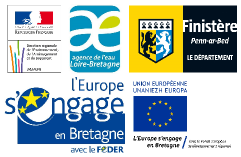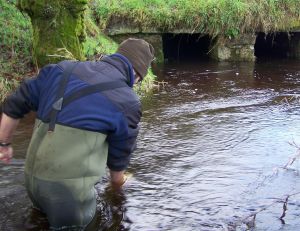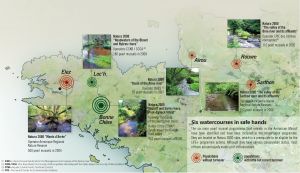Rivières vivantes de Bretagne et de Normandie : Mobilisation pour le retour de la moule perlière d'eau douce
Une action coordonnée par :
31 mars 2017
Recueil d'expériences
Qu'avons nous fait ces six dernières années ? Consultez notre Recueil d'expériences du programme LIFE...
23 janvier 2017
Rapport final 2016
Le rapport final est en ligne avec ses produits livrables et ses annexes !
30 juin 2016
6e Lettre d'information
La sixième lettre d'information est en ligne ! Venez la découvrir !
21 mars 2016
Les mulettes du Sarthon à la loupe !
Des prélèvements ont été réalisés sur certaines mulettes du Sarthon...
07 janvier 2013
Reportage sur Pêche TV
Un reportage sur le LIFE mulette est disponible sur Pêche TV !
- Accueil
- Actualité
- La moule perlière
- Les rivières concernées
- Restauration de l’habitat
- Le programme LIFE+
- Colloque 26 et 27 nov 2014
- Visites station
- Les gestes au quotidien
- Plans Après-LIFE
- Téléchargements
- Revue de presse
- Les partenaires
- Les financeurs
- Liens utiles
- Contactez-nous !

Ils mettent en œuvre le programme :

Ils financent le programme :

English summary
LIFE+ Conservation of the freshwater pearl mussel from the «Massif armoricain»
Project objectives
The project aims to contribute to the restoration of the freshwater pearl mussel Margaritifera margaritifera populations from the «Massif armoricain». It includes six sites, classified as Special Areas of Conservation (SACs), that are known to be a refuge for the main freshwater pearl mussel populations in western France.
The freshwater pearl mussel (or pearl mussel) is a mollusc listed in Annexes II and V of the Habitats Directive and Annex III of the Berne Convention. It is also protected by the French law (decree of 7 October 1992, decree No. 99-615 of 7 July 1999). The Red List of the International Union for Conservation of Nature (IUCN) classifies this species as «endangered» i.e. facing a very high risk of extinction in the wild in the near future. During the last decade, a worldwide reduction of at least 50% of its population has been observed. It is estimated that 90% of the pearl mussel vanished in central Europe during the twentieth century. This species has disappeared from more than 60% of French rivers where it was present at the beginning of the twentieth century. In addition, in some of the remaining rivers the decrease in population size reached more than 90%.
The pearl mussel represents a key indicator species for the river ecosystem quality and is also a model for the design of conservation strategies. During its life cycle it has planktonic stages as well a parasitic one where it lives in the gills of host-fish like salmon. Thus, populations, and particularly the vulnerable young mussels living in river bed sediments, are affected by increases in temperature, pollutants, eutrophication, and sediment extraction.
Studies performed by the NGO «Bretagne Vivante» (Brittany), the «CPIE Collines Normandes» (Normandy) with the help from the regional natural park «Normandy Maine», as well as from several mollusc studies from Lower Normandy (eg. Gilbert Cochet) show the same alarming results: the progressive ageing and disappearance of pearl mussel populations.
This mussel is strongly connected to man since the Neolithic and is thus important in a historical sense. Moreover, its geographical extent and its sensitivity to environmental changes makes it an important bio-indicator. Hence, the freshwater pearl mussel has all the properties of, and was therefore determined as, an umbrella species: i.e. by protecting the pearl mussel the entire river ecosystem will be positively affected.
This project is consistent with both the ongoing National action plan for Nayades in France, and the implementation of the Water Framework Directive to achieve a good ecological status of rivers by 2015.
Given the urgent need to conserve the remaining populations in the «Massif armoricain», the construction of a mussel rearing station will be one of the main tasks of this project. This provides the different age groups of pearl mussels that are necessary to prevent immediate disappearance of this species from the natural environment. Ultimately, the results of the project will provide better understanding of wild populations as well as essential information on how to establish better management and monitoring systems.
The main objective of this LIFE project (01 September 2010 - 31 August 2016), is to maintain and to improve the pearl mussel numbers. Other goals of the project will be: to unite and educate river stakeholders and environmental restoration managers, to improve our knowledge of the species and finally, to be able to ensure the continuity of the actions performed during the project.
Actions and means involved
1. To maintain and to support existing pearl mussel populations:
- One breeding station will be set up in Brittany, and this will help to conserve the species and the genetic characteristics of each population. A method of ex-situ breeding will be established within an existing federal fish hatchery
- The bred mussels will be re-introduced into their natural environment where and when the environment quality allows for it
- Legal restrictions by the Biotope Protection Order («Arrêtés de protection de biotope» (APB)) will protect mussel and host-fish populations by e.g. the creation and regulation of fishing zones and periods. Biotope Protection Order aims to preserve natural areas needed for feeding, breeding, resting or survival of animal or plant species protected by law. It is currently the regulatory process the more flexible and the more efficient to preserve threatened areas. It is particularly suited to deal with emergencies destruction or significant alteration zone.
- Our experience and that of other mussel conservation projects, will be pooled, particularly within the LIFE projects. A close relationship with the responsible structures will be established.
2. To federate river managers and stakeholders:
- The quality of freshwater pearl mussel habitats will be improved by encouraging river managers to help with the implementation of measures on the short-term: e.g. to set up fences, riverbank stabilization, control of farms; but also on the medium-term: as for example land acquisition. Different tools can be used: Natura 2000 contracts, river contracts, land acquisition under the Sensitive Natural Area («Espace Naturel Sensible» (ENS)) policy, etc.
- Stakeholders, fishermen and farmers from watershed, as well as the general public will be educated through the concerted development of educational material.

3. To improve our knowledge:
- The distribution of the freshwater pearl mussel will be ameliorated with a precise mapping of the specimens, their conservation status, age, state of reproduction, etc.
- A genetic analysis will concern the different mussel populations and a study on the relation between mussels and their host-fish will be performed in order to refine the protocol established in the rearing station
- The physico-chemical quality of the water, the quality of the habitat, the substrate, will be monitored to determine, if the reintroduction of young bred mussels is possible
4. To ensure sustainability
Different actions will have to continue after the end of the project and especially, if the environment does not reach a water quality which is good enough to ensure mussels bred in the natural environment.
Expected results
At the end of the project, we expect to have developed an ex-situ system for the breeding of different mussel cohorts for the conservation of wild populations. We anticipate having up to 4000 individuals with an age of 4 and 5 years for each river.
In systems where the environment appropriate, we will re-introduce pearl mussel specimens to the natural environment. We will re-introduce pearl mussels from different age classes (from 0 to 4-5 years) by putting them either in contact with the gills of local host-fish or, in some sites, directly into the substrate.
The protection of wildlife sites will be undertaken. We will encourage the river managers and stakeholders to be highly involved in the project and to implement effective actions to restore the quality of the rivers where mussels are present.
A new map of the distribution and the ecological status of mussel populations is also expected as well as monitoring data about the quality of the selected sites over several years.
-







